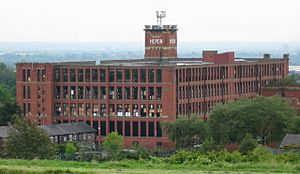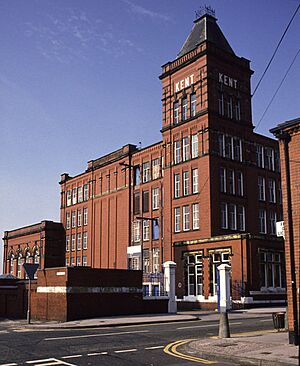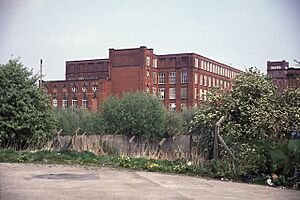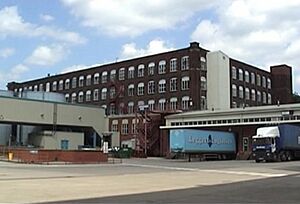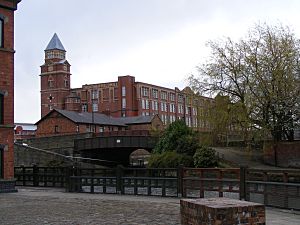List of mills owned by the Lancashire Cotton Corporation Limited facts for kids
The Lancashire Cotton Corporation Limited was a huge company formed in 1929. It became the world's biggest cotton spinner, meaning it made cotton thread. The company bought 104 factories, called mills, and closed about half of them to make less cotton. By 1950, it was still running 53 cotton mills.
Contents
- The Lancashire Cotton Corporation
- What was the LCC?
- Life in a Cotton Mill
- Famous Mills and Their Stories
- Ace Mill: A Giant Warehouse
- Brunswick Mill: From Factory to Flats
- Dawn Mill: From Cotton to Supermarket
- Empress Mill: Wigan's Last Spinner
- Heron Mill: A Mill with a View
- Kent Mill: A Ring Mill for Egyptian Cotton
- Magnet Mill: Now Homes
- Malta Mill: A Powerful Engine
- Manor Mill: The Dome Building
- Mars Mill: A Sister Engine
- May Mill: Old Machines and New Uses
- Mons Mill: A Mill with a Battle Name
- Newby Mill: Now a Distribution Centre
- Orme Mill: Still Standing
- Regent Mill: A Ring Mill
- Royd Mill: Electric Drives
- Rutland Mill: From Cotton to Warehousing
- Texas Mill: Destroyed by Fire
- Trencherfield Mill: A Working Museum
- Tudor Mill: Another Fire Victim
- Other Mills Owned by LCC
- Images for kids
The Lancashire Cotton Corporation
What was the LCC?
The Lancashire Cotton Corporation (LCC) was created on January 23, 1929. Its main goal was to help the cotton industry in Lancashire, England, which was facing tough times. The LCC bought many cotton mills, hoping to make them more efficient and save jobs. It was a very important company in the history of cotton making in the UK.
Life in a Cotton Mill
Cotton mills were busy places where raw cotton was turned into thread. Large steam engines powered the machines inside. These engines had huge flywheels and many ropes that moved all the machinery. For example, the engine at Ace Mill was called 'Mary and Elizabeth' and was very powerful!
Many mills had special machines called 'mule spindles' or 'ring spindles' to spin the cotton. Some mills also had 'doubling' machines, which twisted two or more threads together to make stronger yarn.
Life in the mills was hard work, but these factories were vital for the economy of towns like Oldham, Bolton, and Rochdale.
Famous Mills and Their Stories
The Lancashire Cotton Corporation owned many mills, each with its own history. Here are a few interesting ones:
Ace Mill: A Giant Warehouse
Ace Mill in Hollinwood, Oldham, was a five-story building with a huge floor area. It was powered by a massive 2500 horsepower engine. Today, this old cotton mill is no longer spinning cotton. Instead, it's used as a large warehouse.
Brunswick Mill: From Factory to Flats
Brunswick Mill in Ancoats, Manchester, was one of the biggest mills in Britain when it was built in 1840. It had seven floors and many loading bays right next to the Ashton Canal, making it easy to move cotton. In the 1850s, it had thousands of spindles. Today, Brunswick Mill has been changed into a modern shopping complex and apartments.
Dawn Mill: From Cotton to Supermarket
Dawn Mill in Shaw was built at the start of the 20th century. It had powerful engines named 'Venus' and 'Mars'. This mill spun cotton until it was sold. Later, it became a storage and distribution center for clothes. In 2006, Dawn Mill was demolished to make space for a large supermarket.
Empress Mill: Wigan's Last Spinner
Empress Mill in Ince, Wigan, was special because it was a rare single-story spinning mill. By 1951, it had been updated with new machines. Empress Mill was the very last working cotton spinning mill in Wigan, closing its doors in 1975.
Heron Mill: A Mill with a View
Heron Mill in Hollinwood, Oldham, was built in 1905. It was taken over by the LCC in the 1930s when cotton was very important. It stopped making cotton in 1960. After that, it was used as offices and a warehouse for many years.
Kent Mill: A Ring Mill for Egyptian Cotton
Kent Mill in Chadderton was built in 1908. The LCC changed it from a 'mule mill' to a 'ring mill' to spin special Egyptian cotton. It had 104,000 spindles and a 1500 horsepower steam engine. The mill closed in 1991 and was demolished in 1994.
Magnet Mill: Now Homes
Magnet Mill in Chadderton was built in 1902. The Lancashire Cotton Corporation bought it in the 1930s. It stopped making textiles in 1966 and was soon pulled down. Now, houses stand where the Magnet Mill once was.
Malta Mill: A Powerful Engine
Malta Mill in Middleton was powered by a 1200 horsepower engine built in 1904. This engine had a large flywheel and many ropes to drive the machinery.
Manor Mill: The Dome Building
Manor Mill in Chadderton is a special building because it has an impressive copper-covered dome, like a Byzantine church. It was built in 1906. The mill stopped processing cotton in 1932 but was reopened by the LCC in 1940. It finally closed in 1990.
Mars Mill: A Sister Engine
Mars Mill in Castleton, Rochdale, had a 1700 horsepower engine built in 1908. This engine was very similar to one in another mill called Royton Ring Mill. The mill was demolished in the 1960s.
May Mill: Old Machines and New Uses
May Mill in Pemberton, Wigan, has a long history, with earlier mills on its site burning down. The current May Mill was built starting in 1889. It had two powerful engines named 'Louisa' and 'Helen'. Even in 1980, many of its machines were very old, some from the early 1900s! The mill was later used to make carpet fibers and closed in 1980.
Mons Mill: A Mill with a Battle Name
Mons Mill in Todmorden was a seven-story cotton spinning mill built in 1907. It was first called Hare Mill, but after some financial problems, it was renamed Mons Mill, after a famous battle. The mill closed in 1968. Its chimney and engine house were pulled down in the 1980s, and the site was cleared in 2000.
Newby Mill: Now a Distribution Centre
Newby Mill in Shaw opened in 1890. In 1950, it was making mule yarns. Today, it's part of a huge distribution center for a company called Littlewoods. It's used for storing and moving goods, and you can still see parts of its old cotton heritage, like the engine house.
Orme Mill: Still Standing
Orme Mill in Waterhead, Oldham, was built in 1908. It had a 1250 horsepower engine. In 1960, it was taken over by another company. Today, the mill building is still standing and is used for different industrial businesses.
Regent Mill: A Ring Mill
Regent Mill in Failsworth was designed as a 'ring mill', meaning it had lower ceilings than other mills. It was four stories high and had an 1800 horsepower engine. The LCC bought it around 1930. The mill closed in 1958, and its chimney was demolished in 1964.
Royd Mill: Electric Drives
Royd Mill in Oldham was a smaller mill built in 1907. It had a 900 horsepower engine. By 1961, electric motors were installed to power the machines, and the old steam engine was removed.
Rutland Mill: From Cotton to Warehousing
Rutland Mill in Shaw was built in 1907 and had both ring and mule spindles. By 1964, it was part of the Courtaulds Group. In the late 1980s, it was bought by Littlewoods and used for warehousing. Later, it was demolished and replaced by a new, automated storage warehouse.
Texas Mill: Destroyed by Fire
Texas Mill in Ashton-under-Lyne was powered by a 1500 horsepower engine. It was later used by Courtaulds to make synthetic fibers. Sadly, the mill was destroyed by a fire in 1971.
Trencherfield Mill: A Working Museum
Trencherfield Mill in Wigan was driven by a very powerful 2500 horsepower engine built in 1907. This mill is now part of the Wigan Pier redevelopment area. The amazing steam engine has been restored and you can visit it to see how it worked!
Tudor Mill: Another Fire Victim
Tudor Mill in Ashton-under-Lyne opened in 1903. It was next to the Ashton Canal, which was important for transport. It stopped spinning cotton in the 1960s and was used as a warehouse. Like Texas Mill, it was destroyed by fire in 1970.
Other Mills Owned by LCC
The LCC owned many other mills over the years, even if they weren't still running in 1950.
Vernon Mill: A Stockport Landmark
Vernon Mill in Stockport was another mill owned by the LCC. It was a significant building in the area.
Palmer Mills: Hidden History
Palmer Mills in Stockport were built around 1820 next to the River Goyt. Today, the remains of these old mills can still be seen from a bridge, hidden beneath a modern furniture store.
Orrell's Mill: Pioneering Design
Orrell's Mill in Heaton Norris was a very important mill in history. It was one of the first to use strong cast iron beams in its construction. It was a huge mill with many spindles and looms. It was damaged by fire in the 1960s and later demolished.
Durban Mill: A Powerful Engine
Durban Mill in Oldham had a very powerful 1800 horsepower engine built in 1906. This engine had a huge, heavy flywheel and many ropes to power the mill's machines.
Images for kids


